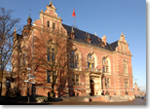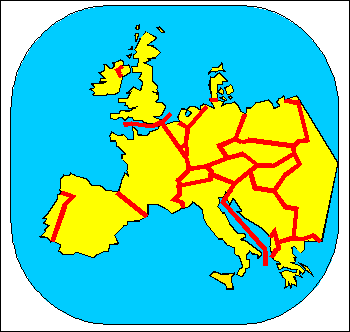Secretariat
Wały Jagiellońskie 1
80-853 Gdańsk Poland
tel. +48 58 301 09 17
tel. +48 58 301 91 23
fax +48 58 301 76 37
 Contact us
Contact us


"Future Outlook for INTERREG"
Speech by Anders Engström
Union of the Baltic Cities, President
at
Nordic Council of Ministers Conference
"Sharing Experiences in Regional Crossborder Co-operation"
Birstonas, Lithuania 28-29 May 2001
Dear Baltic Sea Friends,
Union of the Baltic Cities, UBC is a network of about 100 cities in 10 countries in the Baltic Sea Region. I will introduce UBC more in detail at the morning session tomorrow. Today I will speak about the experiences and the adjustments needed to make Interreg III better suit the sub-national level in the Baltic Sea Region. I am aware that it is most unlikely that any adjustments of the basic concepts of Interreg will occur in this budget period, but perhaps we can experience changes that makes Interreg better adopted for the Baltic Sea Region after 2006.
The aim of Interreg is to diminish the barrier effects of national borders. That is a very good aim and we support it indeed. However, the basic concepts of Interreg were created in the early seventies or late sixties. Even Denmark was not member by then, or had perhaps had just become a member of the European Union. The concepts were shaped after the conditions at that time.
We can characterise the continental European Union as a region, surrounded by water. Furthermore, the centers of growth are located inland, in the famous banana from Northern Italy via west Germany, Northern France, the Benelux countries and the south of England. The trade and the economic links between the countries in continental Europe is by land, on board trucks or on trains.
As can be seen on this picture, there are mainly land borders in the continental Europe, and the basic concepts, still able to clearly trace, has been created form this background.
The geographical structure of this region, the Baltic Sea Region, is quite different. Instead of land, surrounded by water, we can characterise our region as water, surrounded by land. Furthermore, our economic centres are to a large extent facing the sea. The sea also carries a very large part of our foreign trade. From transportation point of view, Finland, Sweden and Norway can be regarded as islands, since the by far largest part of the foreign trade crosses the sea, even now after the opening of the Öresund bridge, of course except the trade between Norway and Sweden.
So in our regions we really have to overcome the barrier effects caused by national borders, but the Interreg could be improved very much to accomplish that task.
Interreg III is, as you know, divided into three strands, A, B and C. Strand A gets minimum 50 % of the money available from the Commission, and C gets 6 %. B gets the remaining money, which is less than half. So the bulk of the Interreg money goes to the eligible Interreg III A regions which are shown on this map. As you can see, except the Öresund region the only eligible regions we can find are between Stockholm and Turku, in the northern part of the Gulf of Bothnia and finally in the Gulf of Finland between Estonia and Finland. We have a serious lack of land borders in our region, but an abundance of maritime borders, and maritime borders are punished in the Interreg system.
Some might argue that Interreg III B solves the problem, but I would like to argue it is not so. First, moneywise III B is, as I mentioned, smaller than III A. Secondly, there are problems with eligible actions.
As you probably know, III B is much more abstract and difficult than III A. It is difficult to find project ideas that both are eligible to the III B rules and at the same time awake enthusiasm and meet urgent needs in the cities. It is much easier in the rules of III A.
Furthermore, the eligible actions are not suitable for maritime cross border co-operation. We can take such a simple thing as the equivalent at maritime borders to land border crossings and joint fire brigades are ferry terminals and sea rescue organisations - but they are not eligible in III B but they can be in III A.
But the eligibility problems are greater than that. I agree that maritime borders are different than land borders, but this means only that there is a great need to think of and investigate how the barrier effects can be reduced at maritime borders, not to degrade them. This must be an urgent task to solve in due time for the Interreg IV: What actions and activities are necessary to solve the problems of barrier effect at maritime borders? How shall Interreg IV be put together so it will be better suited to the needs of the Baltic Sea Region?
I think the problem will be even clearer when Malta and Cyprus will be members, because they would probably also like to participate in measures that diminishes barrier effects of maritime borders.
Another problem is to adapt the cross-border concepts to a situation with very small cross-border interaction, which we have here due to the long isolation by the Iron Curtain. It has forced the cross-border co-operation to start from zero and a very humble beginning, which creates its special problems, different than at the border between for example France and Belgium.
I cannot give any solution, I can only testify of the problems of getting EU funding for co-operation between my city, Kalmar, and our neighbours here in Lithuania. The problems are solved by generous support from the Swedish government that finances our co-operation with primarily Panevezys and with Kaliningrad. Bilateral Swedish support is of course good, but we lack a European Dimension in our projects, and we lack the possibility of multilateral projects.
However, I have a wish list for a future Interreg IV after 2006.
First, I am not certain that there is a need for a division between IIIA and IIIB in the Baltic Sea Region. One idea is to have the Öresund region and the other IIIA regions in the Baltic Sea Region to be parts of one Baltic Sea Region program. Perhaps in this way it is also possible to make the rules less abstract.
Secondly, although the present rules do not say anything of the sizes of projects, the general impression is that Interreg expects large projects, half a million Euro or more. However, we need also a small projects facility, for projects between 50 000 and 500 000 Euro. We have difficulties to spend 500 000 Euro or more for co-operation projects between Kalmar and our partner in Lithuania, for example, when it only is about exchange of experience and similar.
Thirdly, I do think that the local and regional authority levels must be better involved in the further development of Interreg. After all, we are the main users of the program, but the development has been an affair strictly between the European Commission and the national government level. If the program user had been involved in the program development from the beginning, then the Interreg probably would have been better adapted to the needs of the users of the program.
Thank you for your attention.







